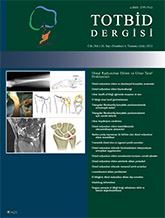
Instability associated with arthritis of the distal radioulnar (DRU) joint is a challenging problem to solve. If bone deformity in the forearm cannot be corrected and soft tissue balance cannot be achieved, salvage procedures could be performed. In salvage surgeries for DRU joint, the aim is to regain pain free, maximal range of motion at the wrist. Salvage surgeries that change the anat-omy of the DRU joint at least to the most, are: Distal ulna hemi-resections (Bower, Watson), Sauvé-Kapandji surgery, Darrach surgery and one bone forearm surgery. Distal ulna hemi-resection; is partial removal of the ulna joint. This procedure should not plan if there are deformities in the radius and ulna. Sauvé-Kapandji surgery; is the fusion of the ulna head to the radius and the process of creating pseudoarthrosis in the ulna. It is preferred for early rheumatoid arthritis and patients with no or correctable deformity in the radius. Darrach surgery; is removal of the distal ulna. It can be applied in sedentary and advanced rheumatoid arthritis patients and patients with noncorrectable deformity in the radius. One bone forearm surgery; is fusion of ulna and radius to make the forearm consist of a single bone. Forearm rotation is totally restricted after this surgery. It is the final surgery where other salvage procedures could not be performed or failed.